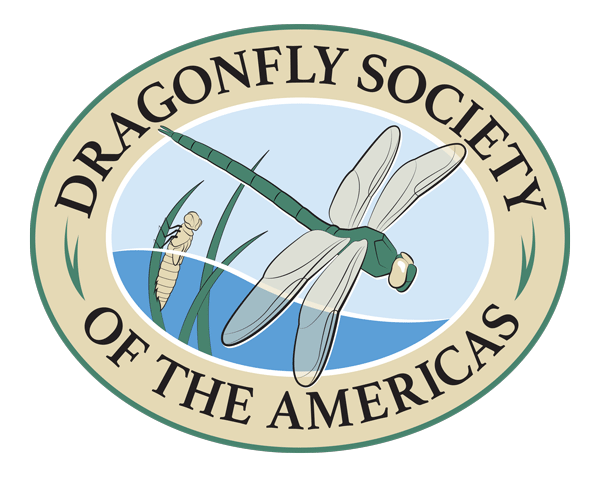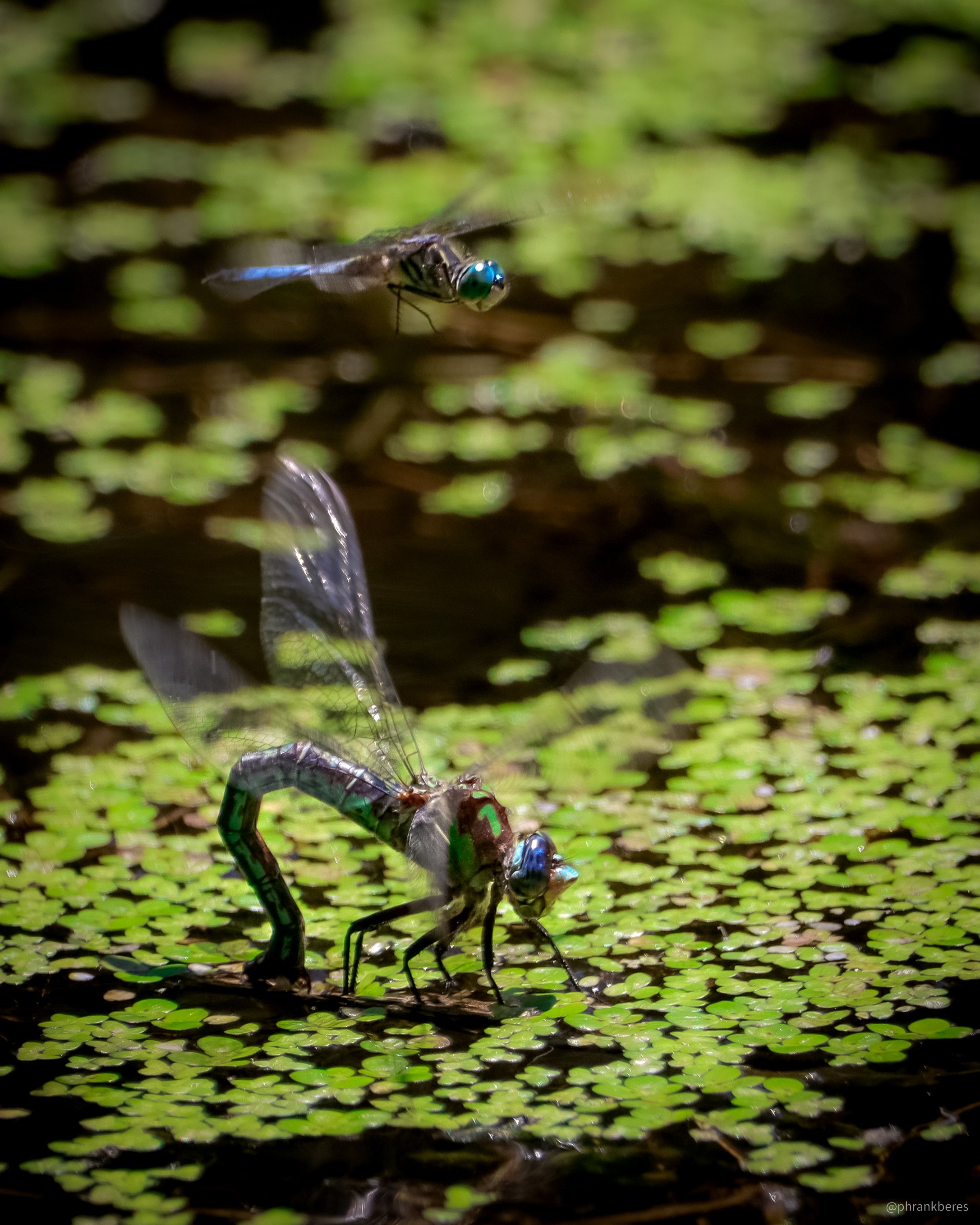N. pentacantha (Cyrano Darner) Ovipositing female. Esopus, NY, USA. 06-22-2020. Photo by Frank Beres.
January Species of the Month: Cyrano Darner (Nasiaeschna pentacantha)
The DSA Species of the Month for January is the Cyrano Darner (Nasiaeschna pentacantha). The Cyrano Darner is the sole member of the monotypic Nasiaeschna genus in the much larger Aeshnidae family, collectively called “darners” in North America. This large darner measures around 2.5 to 2.8 inches (62-73mm) and is widespread from the Great Lakes to Maine, and south to Florida and Texas.
“A great nose may be an index
Of a great soul”
–Edmond Rostand, Cyrano de Bergerac, 1897
Detail of eyes and head of a male N. pentacantha (Cyrano Darner). Esopus, NY, USA. 05-28-2023. Photo by Frank Beres.
Let’s get this out of the way immediately: The common name of N. pentacantha is derived from its large, protruding frons—a reference to the legendary nose of 17th century French poet Cyrano de Bergarac, who was also the subject of a famed 1897 play by Edmond Rostand. The frons is technically more of a forehead on insects, so I’ve come up with a few additional common names just in case: “Highbrow Darner,” “Intelligent Darner,” or perhaps the whimsical “Noggin Darner.” For now, we’ll stick with Cyrano.
The Cyrano Darner is striking in appearance not only for the panache of its great nose, but also in the vibrant blues and greens that are common amongst the darners. These colors are on full display here in the beautiful, multifaceted eyes; in the distinctive, angular markings that point backwards down the abdomen; and even on that famed frons. In flight, the species appears large and intimidating—and it acts intimidating, too.
Male N. pentacantha in-hand after a fortuitous netting attempt. Esopus, NY, USA. 05-28-2023. Photo by Frank Beres.
Detail of eyes and head of a male N. pentacantha (Cyrano Darner). Esopus, NY, USA. 05-28-2023. Photo by Frank Beres.
Cyranos are known for methodical, looping patrol flights with wings angled slightly upward over slow-moving bodies of water, often above pool sections of streams. This should be a boon to dragon-hunters trying to photograph them in-flight, considering that they almost never land in the heat of the day—but they are easily distracted from patrolling by other species that dare to cross through their paths. It is almost guaranteed that every time one gets a Cyrano in focus, they will veer off course to slam into other species with similar behaviors: the River Cruisers (Macromia spp.), Black-shouldered Spinyleg (Dromogomphus spinosus), Prince Baskettail (Epitheca princeps), Common Green Darner (Anax junius), and even the much larger Swamp Darner (Epiaeschna heros). In case you wondered, it takes about 45 minutes of looking through a viewfinder to obtain a perfectly half-sunburnt face.
N. pentacantha in-flight over Burroughs Sanctuary Pond. Photo by Frank Beres. Esopus, NY, USA. 06-17-2022. Photo by Frank Beres.
In addition to hunting in-flight, Cyranos are known for the unique behavior of “gleaning:” the process of plucking perched prey off vegetation. I remember tracking a Cyrano at the former cabin of naturalist author John Burroughs in Esopus, New York, when it suddenly soared upwards out of its monotonous patrol and slammed into the pondside vegetation. I stood, amazed and unable to act, as it took about eight seconds to effortlessly carry a struggling and bewildered Slaty Skimmer (Libellula incesta) into the treetops, presumably for a lunch date.
N. pentacantha oviposits as a Pachydiplax longipennis (Blue Dasher) observes from above. Highland, New York, USA. 06-25-2022. Photo by Frank Beres.
While the Cyrano may be common throughout the southern part of its range, it is an uncommon find here in New York. It may even be in decline as efforts from the 2005-2009 statewide Odonate survey failed to locate the species in any of the eight counties with historical records, leading to a New York Natural Heritage Program state ranking of S2S3 (Imperiled or Vulnerable in this state). However, four new counties were added during the survey, and the first for Ulster County was later recorded on Black Creek in June of 2020. I’ve reliably seen them on pool sections of this stream and nearby lakes ever since. While I’ve never seen them in tandem, I’ve watched freshly-hatched tenerals hang in the canopy and have stumbled upon several instances of egg-laying.
Distribution range of N. pentacantha from OdonataCentral.org (Edited). December 2 2023. (Odonata Central - Dragonfly & Odonate Species Maps and Range Maps)
New York State ranking, distribution, and phenology from the 2010 NY Natural Heritage Program DDS report. New York Dragonfly and Damselfly Survey - NY Natural Heritage Program (nynhp.org)
Like all darners, the Cyrano oviposits by injecting eggs into plant material, with a preference for woody debris. Last year, I watched one that continually whirred its wings while ovipositing into a small stick, creating a small Cyrano-powered raft that traveled almost halfway across the pond, dodging the Blue Dashers and Common Green Darners—how fun is that? I also remember one instance of chasing an ovipositing female, frantically trying to switch lenses while balancing precariously on a fallen log with an impending thunderstorm on the horizon. The adventures of Cyrano never cease.
All the juggling and struggling is worth it for the opportunity to see and document the next generations of Cyrano Darners being secured.
N. pentacantha (Cyrano Darner) Ovipositing female. Esopus, NY, USA. 06-22-2020. Photo by Frank Beres.
References:
Munroe, K. (n.d.). Dragonflies of Northern Virginia. http://www.dragonfliesnva.com/.
New York Natural Heritage Program. 2023. New York Natural Heritage Program Databases. Albany, NY.
Paulson, D. 2011. Dragonflies and Damselflies of the East. Princeton University Press, Princeton,New Jersey, USA.
White, Erin L., Jeffrey D. Corser, and Matthew D. Schlesinger. 2010. The New York Dragonfly and Damselfly Survey 2005-2009: Distribution and Status of the Odonates of New York. New York Natural Heritage Program, New York State Department of Environmental Conservation, Albany, NY.
Frank Beres is a Hudson Valley naturalist and ecologist for the New York City Department of Environmental Protection. In addition to photographing and documenting rare species of Odonates, he leads many interpretive walks each year to introduce others to the wide world of biodiversity. Contact him on Instagram (@phrankberes) or via email at othernaturephoto@gmail.com.










